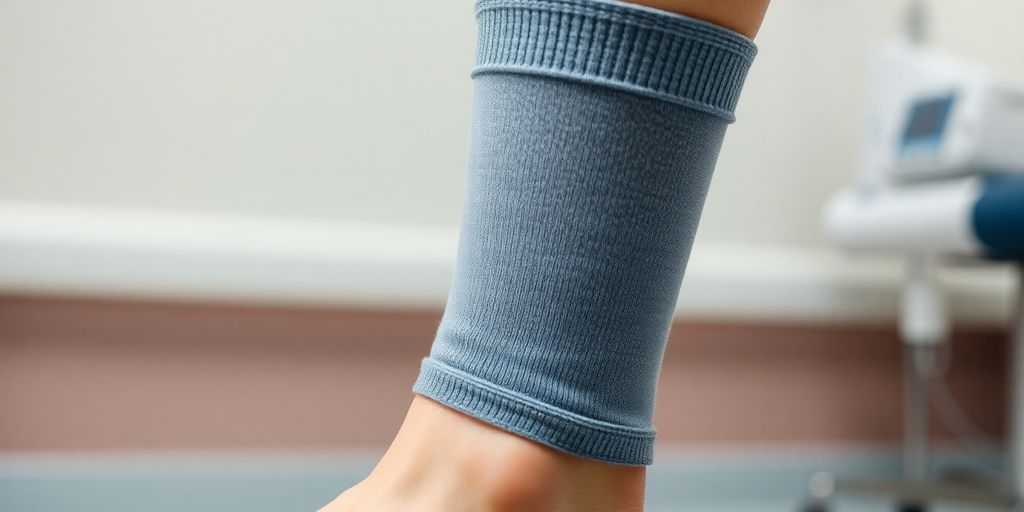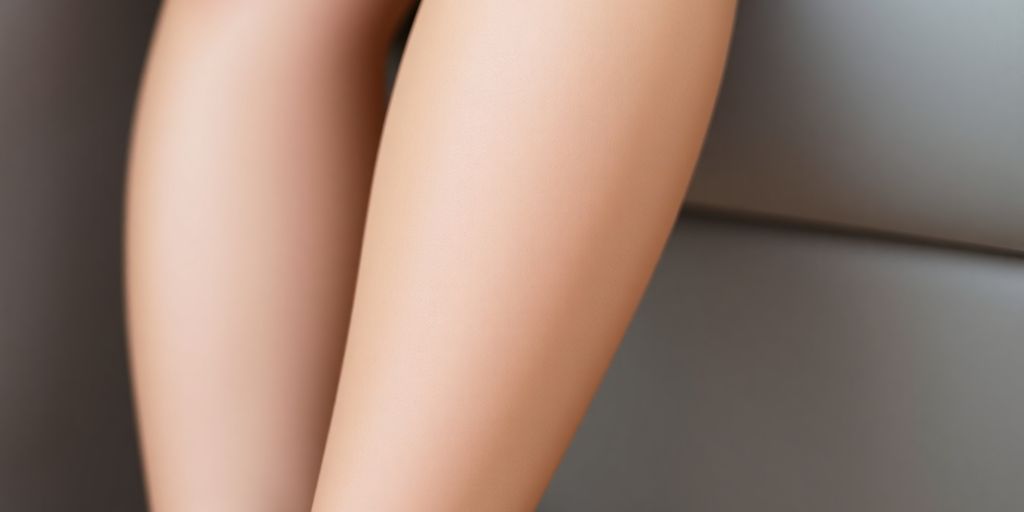When thinking about what is the best compression for DVT, it's pretty clear that getting the right compression can make a big difference. Deep Vein Thrombosis, or DVT, is a serious thing, and compression garments are a common way to help manage it. But with so many options out there, how do you pick the right one? This guide will break down the different types and levels of compression, how they work, and what you should consider to find the best fit for your situation. It's all about making sure you're getting the support you need.
Key Takeaways
- Compression levels, measured in mmHg, range from mild (15-20 mmHg) for daily support to extra firm (40-50 mmHg) for serious medical conditions.
- Compression garments help prevent DVT by making blood flow better, cutting down on swelling, and supporting your veins.
- The best compression for you depends on how bad your condition is, what symptoms you have, and your daily routine.
- Different types of garments like stockings, sleeves, and socks are available, each designed for specific body parts.
- Always talk to a doctor to figure out the right compression level and garment type for your needs.
Understanding Compression Levels for DVT Prevention

Okay, so you're thinking about compression for DVT prevention? Great! But it's not a one-size-fits-all kind of thing. The level of compression matters a lot, and picking the right one is key. It's all measured in millimeters of mercury (mmHg), which basically tells you how tight the garment is. Let's break down the different levels.
Mild Compression: Everyday Support (15-20 mmHg)
This is your everyday, comfy level. Think of it as a gentle hug for your legs. It's good if you're on your feet all day, or sitting for long stretches. It can help with that tired, achy feeling and minor swelling. I used these compression socks when I was pregnant and they helped a ton with leg fatigue.
Moderate Compression: Managing Specific Conditions (20-30 mmHg)
Now we're stepping it up a notch. This level is often used for managing things like varicose veins or preventing DVT during travel or after surgery. It gives more support and helps improve blood flow a bit more than the mild stuff. It's a good middle ground for people who need a little extra help.
Firm Compression: Addressing Serious Issues (30-40 mmHg)
This is where things get more serious. Firm compression is for managing more pronounced varicose veins, edema, or lymphedema. It provides significant support and is usually recommended by a doctor. It's not something you'd just grab off the shelf without talking to a healthcare professional first. It's important to get the right fit and pressure to avoid any problems.
Extra Firm Compression: Severe Medical Conditions (40-50 mmHg)
This is the highest level of compression, and it's reserved for severe medical conditions like severe lymphedema or post-thrombotic syndrome. We're talking serious stuff here. This level of compression needs to be closely monitored by a doctor. It's not for everyday use, and it's crucial to follow medical advice when using this level of compression. It's all about managing serious conditions and preventing complications. Finding the right compression level is essential for comfort and effectiveness.
Choosing the right compression level is super important. Too little, and you won't get the benefits you need. Too much, and you could cause discomfort or even circulation problems. Always talk to your doctor or a qualified healthcare professional to figure out what's best for you. They can assess your specific needs and recommend the right level of compression for your situation.
How Compression Garments Work to Prevent DVT
Compression garments are more than just tight socks or sleeves; they're designed to actively support your circulatory system. They play a vital role in preventing DVT, and understanding how they work can help you appreciate their benefits.
Enhancing Blood Circulation
The primary way compression garments prevent DVT is by improving blood flow in the legs. Think of it like this: your veins have to work against gravity to pump blood back to your heart. Compression garments gently squeeze your legs, helping the veins do their job more efficiently. This is especially important when you're sitting or standing for long periods, as inactivity can cause blood to pool in your legs. This is why compression stockings are so important.
Reducing Swelling and Discomfort
Compression garments also help reduce swelling, also known as edema, in the legs and ankles. When blood flow is sluggish, fluid can leak out of the blood vessels and accumulate in the surrounding tissues. This can cause discomfort, pain, and a feeling of heaviness. By improving circulation, compression garments help prevent fluid buildup and alleviate these symptoms. This is especially helpful for people who experience swelling due to pregnancy, varicose veins, or other medical conditions.
Supporting Veins and Lymphatic System
Compression garments provide external support to the veins, helping them to function properly. This is particularly important for people with weakened or damaged veins, such as those with varicose veins or chronic venous insufficiency. The support helps prevent the veins from stretching and bulging, which can lead to pain and other complications. Furthermore, compression can also aid the lymphatic system, which plays a crucial role in removing waste and excess fluid from the body. By supporting both the veins and the lymphatic system, compression garments help maintain healthy circulation and prevent DVT.
Wearing compression garments is like giving your legs a gentle hug all day long. They provide support, improve circulation, and help prevent blood clots from forming. It's a simple yet effective way to protect your health, especially if you're at risk for DVT.
Factors Influencing the Best Compression for DVT
Choosing the right compression level for DVT prevention isn't a one-size-fits-all situation. Several things come into play, and what works for one person might not be ideal for another. It's about finding the sweet spot that addresses your specific needs and circumstances.
Severity of Your Condition
The seriousness of your condition is a big factor. Someone with mild swelling might only need light compression, while someone with a more severe case of DVT will likely require a higher compression level. Think of it like this:
- Minor swelling, tired legs: Mild compression (15-20 mmHg)
- Moderate swelling, varicose veins: Moderate compression (20-30 mmHg)
- Severe varicose veins, lymphedema: Firm compression (30-40 mmHg)
- Severe DVT, serious lymphatic issues: Extra firm compression (40-50 mmHg)
Individual Symptoms Experienced
Your symptoms are a key indicator. Are you experiencing just a bit of discomfort, or are you dealing with significant pain and swelling? The intensity of your symptoms will help determine the appropriate compression level. For example, if you have aching legs after standing all day, you might benefit from mild compression. But if you're experiencing sharp pain and noticeable swelling, you'll probably need something stronger.
Daily Activities and Lifestyle
What you do every day matters. If you're on your feet all day, a moderate level of compression might help prevent fatigue and swelling. If you spend most of your day sitting, you might need something different. Athletes might use compression garments to help with recovery after intense workouts. It's all about matching the compression to your activity level.
It's important to consider how compression garments fit into your daily routine. If they're uncomfortable or difficult to put on, you're less likely to wear them consistently, which can reduce their effectiveness. Finding a balance between the right compression level and comfort is key for long-term DVT prevention.
Types of Compression Garments for DVT
There are several types of compression garments available, each designed to target specific areas of the body and provide varying levels of support. Choosing the right type can make a big difference in comfort and effectiveness. It's not just about squeezing your legs; it's about getting the right kind of squeeze in the right places.
Compression Stockings
Compression stockings are probably the most well-known type of compression garment. They come in different lengths, from knee-high to thigh-high, and even pantyhose styles. The length you choose depends on where you need the most support. For example, if you're dealing with swelling in your lower legs and ankles, knee-highs might do the trick. But if the swelling extends higher up, you'll want to go with thigh-highs. They're often used for managing varicose veins and preventing DVT, especially after surgery or during long periods of inactivity.
Compression Sleeves
Compression sleeves are designed for the arms, but can also be used for legs. They're not as common as stockings for DVT prevention, but they can be helpful if you have localized swelling or discomfort in a specific area. They're also easier to put on and take off than full stockings, which can be a plus if you have mobility issues.
Compression Socks
Compression socks are similar to stockings but typically shorter, usually ending at the calf. They're a good option for everyday wear and can help improve circulation and reduce fatigue in your legs. They're also popular among athletes for enhancing performance and recovery. If you're looking for something comfortable and easy to wear, compression socks might be a good starting point. Care-Med offers a range of paediatric DVT compression solutions, including socks, stockings, and garments for lymphedema and lipedema.
It's important to remember that not all compression garments are created equal. The material, knit, and construction can all affect how well they work and how comfortable they are to wear. Look for garments made from breathable, moisture-wicking fabrics to prevent skin irritation and keep you cool and dry. Also, pay attention to the fit. A garment that's too tight can restrict circulation, while one that's too loose won't provide enough support.
When to Consider Compression for DVT Prevention
So, when should you actually think about using compression for DVT prevention? It's not a one-size-fits-all thing, and there are definitely times when it makes more sense than others. Let's break it down.
During Pregnancy
Pregnancy can really mess with your circulation. The growing uterus puts pressure on the veins in your pelvis and legs, which can increase the risk of DVT. Plus, hormonal changes during pregnancy can also make your blood more likely to clot. Compression garments, especially stockings, can help keep things moving and reduce the risk. It's always a good idea to chat with your doctor about whether compression is right for you during pregnancy, but it's often recommended, especially if you have other risk factors.
For Long Periods of Inactivity
Think long flights, road trips, or even just sitting at a desk all day. When you're not moving around much, your blood flow slows down, which can increase the risk of clots. Compression can help counteract this by gently squeezing your legs and encouraging blood to flow back to your heart. If you know you're going to be stuck in one place for a while, compression socks or stockings are a pretty easy way to give your circulation a boost. I always pack a pair when I travel!
Post-Surgery Recovery
Surgery can also increase your risk of DVT for a few reasons. First, you're often less active after surgery, which slows down blood flow. Second, surgery itself can trigger your body's clotting system. Compression garments are often prescribed after surgery to help prevent clots from forming. They're usually part of a larger plan that might also include blood thinners and other measures. It's all about getting you back on your feet safely.
It's important to remember that compression garments aren't a substitute for medical advice. If you're concerned about your risk of DVT, talk to your doctor. They can help you figure out the best way to protect yourself.
The Role of Graduated Pressure in DVT Compression
Graduated compression is a key feature in effective DVT prevention. Instead of applying uniform pressure, these garments are designed to exert varying levels of pressure, which plays a vital role in supporting healthy blood flow. This graduated approach is what makes compression therapy so effective in preventing DVT.
Highest Pressure at the Ankle
The compression is strongest at the ankle. This higher pressure helps to counteract the effects of gravity, which tends to pull blood downwards and can lead to pooling in the lower legs. Think of it as a gentle nudge, encouraging blood to move upwards.
Decreasing Pressure Up the Leg
As the compression garment moves up the leg, the pressure gradually decreases. This decreasing gradient is important because it mimics the natural pressure changes that occur in healthy veins. It's like a carefully calibrated system that works in harmony with your body's own circulatory mechanisms.
Assisting Blood Flow Towards the Heart
The graduated pressure profile is specifically designed to assist blood flow back towards the heart. By applying the most pressure at the ankle and gradually reducing it up the leg, the garment helps to push blood upwards against gravity. This is especially important for people who are at risk of developing blood clots, or who spend long periods sitting or standing. It's all about giving your circulatory system a helping hand.
The effectiveness of graduated compression relies on consistent and proper use. Make sure the garment fits correctly and is applied smoothly to ensure the pressure gradient is maintained. This will maximize the benefits and minimize any potential discomfort or complications.
Consulting a Healthcare Professional for DVT Compression

It's easy to get lost in the world of compression levels and garment types. Before you buy anything, talking to a doctor is a smart move. They can give you advice that's specific to you.
Determining the Right Compression Level
Figuring out the right compression level isn't always straightforward. What works for one person might not work for another. A healthcare pro can look at your medical history, current health issues, and how bad your symptoms are to figure out the best level for you. For example, someone with minor swelling might only need mild compression, while someone dealing with deep vein thrombosis might need something stronger. Getting this right from the start can make a big difference in how effective the compression is.
Tailoring Garment Selection to Your Needs
There are tons of compression garments out there – stockings, socks, sleeves, you name it. Knowing which one is best for you can be tough. A doctor can help you pick the right type and size based on where you need the compression and what you'll be doing while wearing it. They can also consider things like how easy it is to put on and take off, especially if you have mobility issues. Here's a quick look at some common recommendations:
- Stockings: Good for overall leg coverage.
- Socks: Ideal for ankle and calf support.
- Sleeves: Useful for arm swelling.
Ensuring Optimal Effectiveness and Comfort
Just wearing compression garments isn't enough; you need to wear them correctly. A healthcare professional can show you how to put them on properly, how often to wear them, and what to watch out for. They can also help you adjust the compression level if needed and spot any potential problems early on. This makes sure you get the most benefit from the compression wear while staying comfortable.
It's important to remember that compression garments are a medical device, not just a fashion statement. Using them without proper guidance can sometimes do more harm than good. Always seek professional advice to ensure you're using them safely and effectively.
Wrapping It Up
So, we've talked a lot about compression for DVT. It's pretty clear there isn't just one "best" option for everyone. What works for one person might not be right for another. It really comes down to what your doctor says, what your body needs, and even what feels okay for you to wear every day. The main thing is to get that blood moving and keep those veins happy. Don't just guess; talk to a pro to figure out the right compression level and type for your situation. Getting it right can make a big difference in how you feel and how your body works.
Frequently Asked Questions
What is DVT?
DVT stands for Deep Vein Thrombosis. It's a serious condition where a blood clot forms in a deep vein, usually in the leg. This clot can be dangerous if it breaks loose and travels to the lungs.
How do compression garments help prevent DVT?
Compression garments, like special socks or stockings, gently squeeze your legs. This pressure helps push blood back up towards your heart, stopping it from pooling in your legs and forming clots. It's like giving your veins a helpful squeeze.
What's the right compression level for me?
The 'best' compression level depends on your specific needs. For mild swelling or long travel, a lighter squeeze (like 15-20 mmHg) might be enough. For more serious conditions or after surgery, a doctor might suggest a stronger squeeze (like 30-40 mmHg). It's always best to ask a doctor.
What kinds of compression garments are there?
You can find compression garments in different forms, like socks, stockings that go up to your knee or thigh, and even sleeves for your arms. The type you need depends on where you need the compression and what your doctor suggests.
When should I think about using compression for DVT prevention?
You might need compression if you're going on a long trip, are pregnant, have to sit or stand for many hours, or are recovering from surgery. These situations can make you more likely to get DVT, and compression can help prevent it.
Do I need to talk to a doctor before using compression garments?
Yes, it's really important! A doctor or a healthcare professional can figure out the exact compression level you need and make sure the garment fits you correctly. A good fit means it will work best and be comfortable.




Share:
Understanding Chronic Venous Insufficiency: A Comprehensive Guide
Understanding Deep Vein Thrombosis Compression Socks & Stockings: Your Guide to DVT Prevention